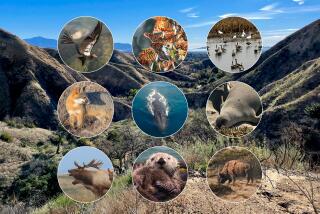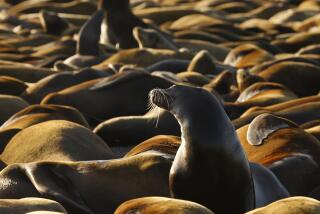Elephant seals make this day unforgettable
ANO NUEVO STATE RESERVE — As the children reflect on what they have just witnessed, one exclaims to another, “I’d like to be a little guy, so I could hide from everyone.”
It’s a sentiment perhaps shared by many children at some point in their lives, and maybe even by young elephant seals here as they struggle to exist among so many large and testy adults.
The fourth-graders from nearby Rio del Mar school have just seen a large blubbery male nearly squash a forlorn pup searching for its mother.
They gasp at oozing scars on the neck of another large male, who has lost a brutal fight -- over something so seemingly unimportant as a female!
Indeed, life can appear cruel, whether one has two legs or four, or in this case, mere flippers.
But life can also be exhilarating and full of wonders, and it seems no different for the northern elephant seals that spend the winter at this remote, wind-swept state park 55 miles south of San Francisco.
In fact, this is one of the wildest romps in the hay known to the animal kingdom, involving beasts that can measure 16 feet and weigh 5,000 pounds.
The testiness among the adults -- nearly 500 males and 2,000 females at peak breeding season in late January -- stems from all the hormones swirling around like pollen during a blustery spring bloom.
About 40,000 tourists a year view the spectacle from Dec. 15 through March 31, and many are children whose innocence, thankfully, enables them to understand only so much.
“Of course it helps to have docents who understand their audience,” ranger Terry Kiser says.
*
The 2 1/2 -hour, $5 walks require advance reservations and entail a mile-long hike to and from a rocky promontory named Punta de Ano Nuevo, or New Year’s Point, by Spanish explorer Sebastian Vizcaino’s crew on Jan. 3, 1603.
As the fourth-grade explorers march purposefully down the discovery trail, docent Trevlyn Williams explains what they’re about to encounter.
“These animals are not here to entertain us,” she says. “They’re here to do the things that are part of their life cycle.”
The fog lifts in time to reveal, littered among the dunes, what look like gargantuan black jellybeans with puppy dog eyes.
They are “weaners,” 300-pound pups abandoned by mothers who have returned to sea. They live off fat reserves until instinct kicks in and they learn to swim and catch fish.
Their mothers have been driven away by hunger and Williams asks if any of the children know where they go. An arm springs up and a boy guesses China.
The docent explains that they swim to the Pacific Northwest and spend months feeding on squid, fish and small sharks and rays during hunting forays as deep as 5,000 feet.
Aside from the breeding season, elephant seals return only once, in the spring or summer, to molt, or “take off their skin,” as another student explains to classmates.
For a long while, it was believed that Northern elephant seals had been hunted to extinction in the mid-1800s, but near the turn of that century, a small population was discovered on Guadalupe Island off Baja California.
From that group, thanks to protective measures, they expanded their territory and now number more than 160,000.
Their primary rookery off California is San Miguel Island, the westernmost of the Channel Islands.
But coastal rookeries such as Ano Nuevo and, more recently, Piedras Blancas near San Simeon produce more than 2,000 pups each season.
Adult males arrive first, in early December, and wage fierce battles for dominance. Females arrive soon thereafter, each giving birth to a single pup, conceived the year before. They form harems and nurse their young for about four weeks.
Pondering so many weaners around him, a boy asks why the mothers have to have a new pup every year.
“Aren’t they happy with just one?” he says.
Williams replies that out of every 1,000 pups born, only 160, or 16%, become adults, so survival of the species requires seasonal births.
Elephant seals are a favorite food of killer whales and great white sharks, the docent explains, and in the haze of this cool morning the rippling green ocean looks downright forbidding.
At the main beach, the largest bulls are lounging amid what is left of their harems.
These alpha males, distinguishable by their pendulous noses -- hence the name elephant seal -- guard their females warily.
“I would rather be a weaner because I wouldn’t be able to fight and get bloody with all those scratches,” one boy tells another.
“Yeah, but then you’d be crushed,” the other boy responds, in reference to the incident involving the forlorn pup, which somehow squirmed free.
At the waterline, adult males without harems have lined up to ambush females as they attempt to return to the sea.
Several may chase a female after it has left the harem, and oftentimes the female, weakened by her lengthy ordeal -- she does not eat during her three months ashore -- must submit to many before she attains freedom.
Fortunately, the fourth-graders are spared witnessing a scene that would require some creative explaining by the docent. But then again it might easily be passed off as just a friendly, albeit awkward, game of tag.
More to Read
Sign up for The Wild
We’ll help you find the best places to hike, bike and run, as well as the perfect silent spots for meditation and yoga.
You may occasionally receive promotional content from the Los Angeles Times.






